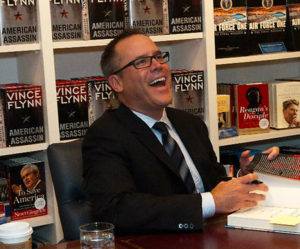
It’s hard to believe that today is the sixth anniversary of Vince Flynn’s passing. The hole it left in the hearts of his friends, family, and readers is something that’s often in the back of my mind when I write.
As June 19 approached and I started working on my sixth book in the Rapp series, I found myself thinking about Vince’s impact on the contemporary thriller genre. And, of course, what I’ve learned from him.
Taking It Mainstream
Vince and I both published our debut novels—Term Limits and Rising Phoenix—in the late 1990s. At that time, the Internet barely existed, social media was years off, and the impact of the 24-hour news cycle was fairly muted. Commentary on the state of the world was largely disseminated the old-fashioned way—evening news programs, print, and radio. Major changes were on the horizon, though, and Vince seemed to understand that before many of the rest of us.
Vince wasn’t the first novelist to have the media look to him for analysis of the subjects he wrote about. Tom Clancy is a classic example of how a fiction writer can become a legitimate expert with a mountain of research and the right contacts. Vince, though, made it all seem so easy—his natural charisma and strongly held beliefs captivated audiences in a way that even Clancy couldn’t. He got readers thinking of thriller writers as something more than people squirreled away in their basements hammering on keyboards.
Recurring Characters Are Important
Building a series around a single character is hard. Really hard. You have to figure out a way to bring new readers up to speed while not boring fans with endless historical recaps. You have to create a long arc out of that character’s life, making him or her evolve in a realistic way. And you have to find an endless stream of trouble for them to get into. At the start of my career I wrote five novels about an FBI agent named Mark Beamon (books 1, 2, 3, 4, and 5). After a while, though, I figured my readers must be getting tired of him and moved on.
What I’ve come to realize is that while I spent every day with Mark, my readers had a very different experience. For them, he was an old friend they only saw once a year when a book came out. It still surprises me how much email I get about that unconventional FBI man—even more than a decade after his last appearance in a book.
I think Vince had a much better feel for the relationship between character and reader than I did at that time. He was willing to not only continue writing about Mitch, but also to go back and fill in his early years. That’s not something I’d even considered before sitting down and really studying the universe he created. In the end, it was kind of an obvious eureka moment. I realized that I had never gotten tired of reading about my favorite series characters. Why would anyone else?
You Can’t Have Too Many Friends
My fondest memory of my involvement in the series was sitting in the packed auditorium of Vince’s high school during the release of The Survivor. He tended to name his characters after people he knew and many stood up to discuss their namesake and often described how that character had died horribly at the hands of Mitch Rapp. I still laugh when I think about those stories, but what I remember most is the size of the crowd. The number of lives Vince touched is mind-boggling.
So let’s raise a glass to Vince today and once again thank him for everything he’s given us.
Want to know how I prepared for taking over the Rapp series? I describe my process in Stepping Into Vince Flynn’s Shoes Part 1, Part 2, and Part 3.